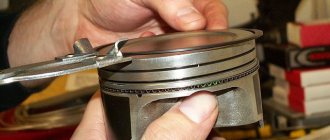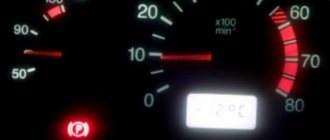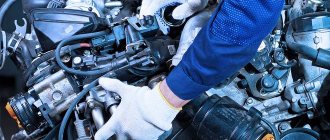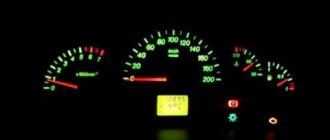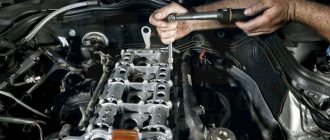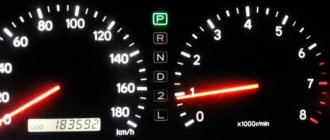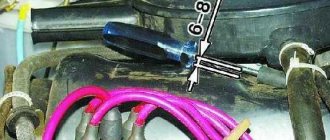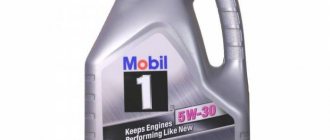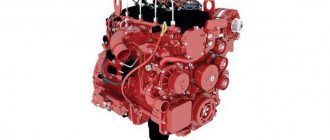Why might a car start to jerk?
So, if your car begins to make “tearing” movements that are not typical for it and have not appeared before, you should do:
- Think about candles. Check their functionality. Replace if necessary.
- Check the car's wiring, and in particular the ignition coil.
- Check the injectors; they may be clogged and cause the jerking.
- Don't forget about air and fuel filters.
- If you have a carburetor, check the ignition timing
- Check the fuel pump. This may be causing the gasoline to flow unevenly.
- Check fuel pressure. Perhaps there is simply not enough power
Possible causes, depending on the type of car engine, and their elimination will be discussed below.
If you have an injector
Jerking movements are a common phenomenon, especially if your car is more than three years old and has been actively used during this period. Photo: 111.urall2.ru
The problem arises due to the fact that when the engine is still cold or just starting to warm up, there is a sudden “decline” in speed, and the difference between the deviation and the norm is a fraction of a second. The number of revolutions varies from five hundred to one and a half thousand. Further, as the engine warms up more, the number of revolutions is normalized, dips and drops disappear and do not recur until the next time, when the engine cools down again and it starts to be put into action again. Such “tricks” can discourage even the most experienced car enthusiast. And the reason for this action is just the sensor. Yes, temperature sensor.
With an injector, such problems can also arise due to the fact that the engine is equipped with an electronic fuel injection system. And the reason lies in the improper supply of air. It all starts with the control unit incorrectly calculating the required amount of air to enter. Air enters the cylinders and the injector valves open. But more air gets in than necessary! Consequently, the throttle sensor is triggered, along with the temperature sensor indicating that the engine has already warmed up and less gasoline needs to be spent. The computer is in shock; it doesn’t understand what to do with this extra air.
- The problem may also lie in the ignition system. Look for faults either in the wiring, or in the spark plugs, or in the ignition coil. In any case, you will have to replace the non-functioning element.
- Another cause could be a stuck crankcase ventilation valve.
If you have a carburetor
Jerking of a carburetor car without any suspicious or incomprehensible sounds or grinding noises may indicate problems or malfunctions of the carburetor itself or the ignition system.
In most cases, cars with this type of engine jerk precisely because it is clogged. Photo: cdn.klimg.com
What to do in this case? Under no circumstances should you be self-willed or self-made ! Contact a specialist. It will clean the carburetor channels, idle system, and jets. The specialist will also check the carburetor properly; if there is any mechanical damage that could be causing the car to jerk, he will quickly fix it. One such damage is a stuck carburetor throttle valve. Due to this, the engine cannot gain the power it needs and the car simply begins to jerk.
The car stalls while driving, then starts. Possible causes, elimination
Stas [stas90]
08/17/2017, Views: 130276
Often car owners are faced with a very unpleasant problem: the car suddenly stalls while driving. Then immediately, perhaps after a certain time, it starts up again and drives as if nothing had happened. Such faults at service stations belong to the class of flickering faults; many workshops charge double the cost for their repair. And this is understandable: it can be difficult to detect. After all, as a rule, the so-called general effect works here in reverse. If an auto electrician comes to such a call, the car starts up as if nothing had happened and works until the technician leaves. I myself have found myself in such situations more than once. First, let's figure out, in general, what is needed for the engine to work.
Conditions for normal engine operation
For stable operation, internal combustion engines require:
- constant injection of air, and in proportions corresponding to the fuel;
- optimal pressure in the ramp;
- normally working nozzles (injectors);
- correct ignition angle;
- serviceable sensors and actuators of the engine control unit;
- required compression;
- in gasoline cars - plus an ignition spark.
In motorist parlance, an engine needs air, fuel, compression and ignition.
From the point of view of the likelihood of failure of the internal combustion engine, gasoline engines are more vulnerable, because they have an additional system - a high-voltage ignition unit, which is very sensitive to operating weather conditions. Drivers know that once a diesel engine is started, it can “burb” all day long, although not always.
Why does it happen that a car stalls and then starts? The most likely causes of this malfunction include:
1. Immobilizer problems
An immobilizer poses a great danger to most motorists. And this is understandable: you can’t deal with it without special equipment, and the services of auto electricians to fix problems with the immobilizer are expensive. If for some reason the immobilizer blocks the engine control unit, then different car models behave differently. In BMW, if there are problems with the immobilizer, the starter usually does not even spin; most models allow you to try to start it. But in Renault, as in some other models, the engine usually starts, but after a few seconds it stalls. Then it starts again, and after the same time it stalls. This can go on indefinitely.
Immobilizer synchronization failure occurs for the following reasons:
- use of a non-original key or loss of a chip from it;
- battery discharge in the key, if the circuit provides power to the chip;
- breakage of the pumping loop (located in the area of the lock cylinder);
- failures of car alarms with auto start (transponder);
- Malfunctions in the power supply circuits of the engine control unit, immo.
Just in case, you can check if your key has a chip.
If your car has an on-board computer, an immobilizer failure will be indicated in the form of a message such as IMMO or SECRET SERVICE, KEY or a blinking yellow LED. It should be remembered that if you started the car and drove it a few hundred meters, the immobilizer has already synchronized with the engine control unit, its sudden stop will in no way be related to this problem. That is: stopping the engine while driving is not an immobilizer problem!
2. Crankshaft sensor malfunction
It is responsible for overall ignition timing in both gasoline and diesel engines. If the sensor is faulty, then in 95% of cases the car will not start at all. But if the sensor is on the verge of its performance, then the engine may fail. The fact is that the sensor is usually electromagnetic. It represents an inductor wound with an extremely thin wire around a magnetic core. During use and wear, moisture may enter it. When the engine heats up while driving, the sensor coils may open and the engine stalls. Then, while you are struggling to start it, the engine cools down, the sensor coils close again, and the car starts up as if it should. So: a typical situation for a faulty crankshaft sensor: the engine starts when cold without problems, after 15 minutes of driving it suddenly stalls, then, after you wander around the car for half an hour, it starts again without problems. Advice for car enthusiasts - moisten a rag with cold water and place it on the sensor. Somehow you will get home while the sensor is cooling.
By the way, this malfunction may not be diagnosed when it is cold.
3. Flow meter malfunction
This sensor is involved in the quality formation of the mixture. If the flow meter is clogged (this often happens on run-down engines, it becomes clogged with oil), the mixture is formed enriched, it can flood the spark plugs. At idle speed in traffic jams or when coasting, this can cause the engine to stall. Then the engine starts with difficulty again, and so on. You can try cleaning the flow meter with carburetor cleaner. Many car enthusiasts turn it off altogether and, if the car stops stalling, they drive like this for a couple of years.
Installing a new flow meter to replace a heavily contaminated old one solves the problem for a short time. If the piston group or valve stem seals are very worn, the sensor will soon become dirty again.
4. Ignition system for gasoline internal combustion engines
If one of the spark plugs floods or one of the high-voltage wires breaks, the engine usually does not stop. But if the ignition coil (if it is single or double) breaks down when heated, then the car may periodically stall, then start again after a while. Sometimes the coil has microcracks. In wet weather, moisture can get in there and the car may stop suddenly. Sometimes during a rainstorm or if it gets into a puddle, the ignition system becomes flooded with rainwater. Then, as it dries, everything returns to normal. There is only one way to check the ignition coil: throw in a known good one, because a broken coil can ring normally using a multimeter.
5. Idle speed control
If the idle speed is not adjusted correctly, or the governor drive is stuck, the engine may stop at idle speed. You can try cleaning bypass regulators and regulators with stepper motors.
6. Air leak
Usually leads to uneven operation of the engine, which may stall when the accelerator pedal is suddenly moved. Many service stations use smoke machines to search for leaks. Experienced mechanics use a good cigarette.
7. High pressure pump wear
If you suspect the fuel pump, it is better to remove it and take it for diagnostics.
8. Low pressure in the ramp
Typically, engine shutdown occurs due to the fault of the electronic valve pressure regulator installed in the fuel pump. As a rule, flushing the valve does nothing.
9. Fuel pump wear
In many situations, the fuel pump remains in visually working condition, that is, it seems to be pumping. But its productivity and pressure drop to critical levels. The impeller begins to pump, then the pressure decreases by an order of magnitude. The car keeps moving and then shuts up. Change the fuel pump without question. Now the pumps themselves are inexpensive, they can be replaced without equipment, which costs money.
10. Car alarm failures
Frequent malfunction. If the alarm is installed by a non-professional, even worse, in garages, it may begin to fail immediately. After 7 years of operation, all alarms begin to fail. Typically, alarm systems use fuel pump circuits to block theft. If the signal fails, fuel is cut off. Nowadays it has generally become fashionable not to install alarms, but to turn them off. There are more and more such calls to service stations. Advice: install alarms only at proven service stations, otherwise you won’t find anything in a couple of years; When buying a used car, find out the coordinates of who installed the car alarm.
If your car begins to periodically stall while driving, then start, immediately solve the problem, determine the cause of the problem and fix it. Otherwise, sooner or later it will stall for a long time.
Read about troubleshooting other problems on my blog.
Troit twitches and does not go when cold - logbook FIAT Ulysse Sweet cherry 2003 on DRIVE2
I’ve been fighting with the car for over a month now and still nothing... Symptoms lately: When you start it cold, the engine runs fine for 5-10 seconds, then it starts to twitch, the revs fluctuate, and it stalls. If you start it right away, you hear a pop from below, but if you hold it in the second position for 2-3 seconds, there is no pop. When driving, it stalls, if you turn it off, you start it right away, then it may start again, this happens haphazardly. It barely moves, again there is a popping sound from below - it seems like the fuel is burning out. you drive like this for 5-10 km, everything becomes normal, the car works like a clock, it drives calmly, only at xx there is a slight twitching at regular intervals. If it sits for a long time or in the morning everything repeats again. Diagnostics at the beginning of a permanent error in the camshaft sensor - changed it. I changed the spark plugs. Eliminated air leaks - installed new gaskets on the intake manifold, turned off the injectors that were not working. Changed the main lambda. Nothing remains as it was. I exclude injectors, since everything works the same on both gas and gasoline. Cleaned the throttle valve. The coil isn’t even a year old yet, the devil doesn’t know what to do. I’ll send it in for diagnostics again, let them figure it out...
PS: Does anyone have any thoughts?
Jerks when cold. Cured. — logbook of Toyota Avensis 2000 on DRIVE2
The mustachioed man is sick. But the point is this: I start up in the morning, warm up the engine a little (by the way, I always do this, regardless of weather conditions or the degree of lateness for work), and start driving. When accelerating in first and second gears, the engine begins to twitch. You release the gas a little - it accelerates smoothly, if you go too far - there's more twitching. And not a series, but one-time ones. When the engine reaches operating temperature, everything levels out and becomes as it should.
At the first appearance of symptoms, I strongly scolded myself for refueling at the PTC. I chalked it up to shitty low-quality gasoline. But everything happened again when we returned to our native Gazprom Benz.
Who thinks about this? Where to dig?
One of these days I’ll replace the spark plugs, although I think I installed new original ones in the spring. Update: cured The problem turned out to be in the old high-voltage wires. Today I temporarily installed the Russian equivalent and the problem went away. At the same time, I waved the candles before winter. Usatiy is back in action!
Thanks everyone for the advice. Although the car is far from the first, I really didn’t know where to dig!
Price: 3,000 ₽ Mileage: 249,000 km
Why does the car jerk while driving?
The situation when a car starts to move unevenly is familiar to every motorist. The problem, which manifests itself in jerking and jerking, can be caused by the incorrect operation of various automotive systems. Today we will look at the common symptoms of this “disease” and share recommendations for eliminating them.
So, a violation of the smoothness of the ride and the associated jerks of the car occur:
- when starting off;
- during acceleration;
- at low speeds;
- when the engine is operating at maximum load;
- in transient conditions;
- in all of the above cases.
Determining the culprit of the malfunction
The car can “twitch” while driving for various reasons, so you should adhere to a certain troubleshooting algorithm. If there are no obvious signs of transmission malfunction, then first of all we check the power and ignition system.
Failures in the engine power system
Malfunctions in the system for preparing and supplying the fuel mixture are indicated by jerking of the machine in motion. In this case, the malfunction can manifest itself in different ways:
- The car begins to twitch when the accelerator pedal is pressed sharply. At the same time, instead of gaining speed, the engine runs jerkily, and therefore the car picks up speed very reluctantly. At some stage, the twitching stops and the engine “picks up.” In other cases, the power unit stalls when the throttle is maximally open, or jerking occurs when the gas is released.
- The unevenness of the ride appears unexpectedly - when the car is moving at a constant speed, in a stable speed mode.
As you can see, uneven engine operation can appear both when the crankshaft speed changes sharply or smoothly in one direction or another, or when operating at stable speeds. The reason for these phenomena is a simple lack of combustible mixture, due to which the engine simply cannot develop power sufficient to overcome the resistance of the transmission.
To eliminate negative phenomena, we check several main components of the power system:
1. Filter. Even with a working fuel pump and a clean fuel line, the engine will begin to starve if the fuel filter is clogged with dirt. The way out is to replace or clean the filter element - it all depends on where exactly the blockage occurred. The fact is that car engines have several cleaning elements installed along the fuel path. If you are dealing with an injection internal combustion engine, then you should pay attention to the third filter element located after the fuel pump. Designed to separate the smallest particles, it clogs quite often, which is why the gas pump cannot pump the required volume of fuel through it. For carburetor cars, we check both the third filter installed in front of the carburetor, and the second one - it is located between the fuel tank and the fuel pump. If replacing them did not yield anything, then you should check the coarse filter installed on the fuel receiver. In addition, the cause of insufficient fuel supply may be the mesh located in front of the float chamber in the carburetor body.
2. Throttle assembly . Malfunctions in the throttle can be caused by wear and damage to its parts and contamination. And if the first requires serious repairs, then in the second case, simple cleaning of the throttle assembly elements mechanically will help. In the case of carburetor internal combustion engines, the situation is more complicated, because you will have to completely disassemble the carburetor and clean all channels, jets, diffusers, etc.
